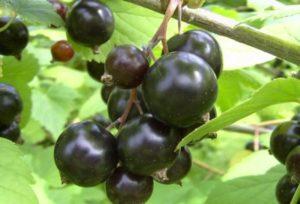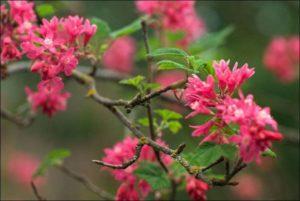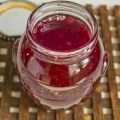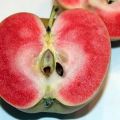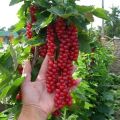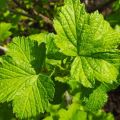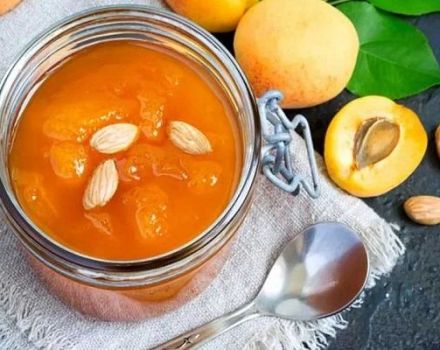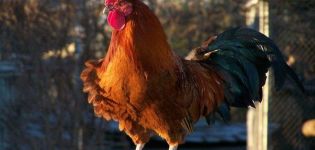Description and characteristics of the Black Pearl currant variety, planting and care
About 200 varieties of delicious berries have been bred by breeders and entered into the State Register. One of the popular varieties of black currant is Black Pearl, recognized as a masterpiece of Russian selection as a result of crossing the hybrids of Brodthorpe and Minay Shmyrev. This variety is a real storehouse of vitamins, beautiful, high-yielding and unpretentious berry for cultivation.
Description of the variety
Black pearls are a mid-season currant variety. Full name - Golden Black Pearl. In appearance, it bears similarities with gooseberries and blueberries.
In the course of crossing the original varieties, the variety differs from its relatives:
- high self-fertility;
- kidney mite resistance;
- fragrant flowers;
- winter hardiness with resistance to frost up to -30 degrees;
- early flowering period (mid-May), in July you can already harvest the first crop up to 5 kg from 1 bush.
The maximum fertility is observed in the 4-5th year of cultivation. Black pearls give stable yields annually and up to 12-15 years in one place.
Leaves
Currant leaves are smooth, dull, with white edges bent inward. The main color is light green. The peculiarity of the leaves is the downward direction, bending to the roots and pointed corners (5 pieces).

Flowers
The flowers of the Black Pearl are golden, goblet with tassels and red sepals.
Fruit
The shape of the berries is round. Weight - 1.2-1.5 g. Color is black, like pearl beads, shining in sunlight. The peel of the fruit is dense with large-seeded pulp inside.
Brushes with berries ripen evenly, do not crumble, holding on to the brushes for a long time. They are firmly held on the stalks and come off dry, despite all the juiciness. They are collected mainly by hand and are quite suitable for transportation.
Characteristics of currant Black pearl
Black pearls bear similarities to gooseberries. It grows vertically, like a shrub, up to 1.5 m in height. Young shoots begin to sag down during regrowth. The branches, as they grow older, begin to change in color to gray-yellow. Buds are latticed, pink, growing on short stems of elongated shoots.
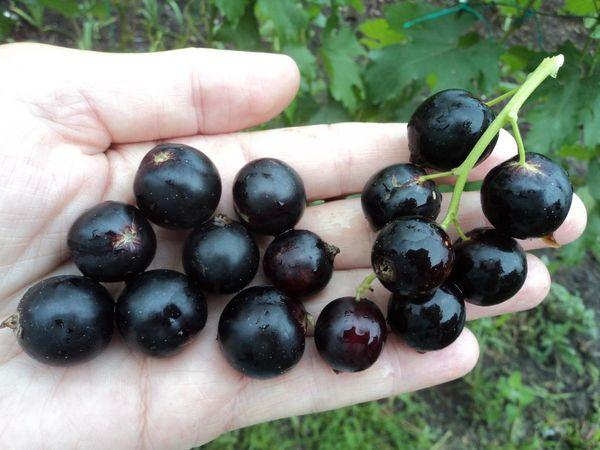
Key Features of Black Pearl:
- bushes - spreading with yellowish lignified branches;
- berries - round, uniform in size, shiny in the sun like pearls;
- foliage - not thickened, with corners looking down, which is important for aeration and lighting;
- fruiting - regular;
- petioles are strong.
Ripening period is average. The yield is stable.
Reference! Black pearls are a self-fertile variety of currants, therefore, regardless of bees, they are quite resistant to kidney mites and anthracnose during flowering. Although not resistant to powdery mildew.
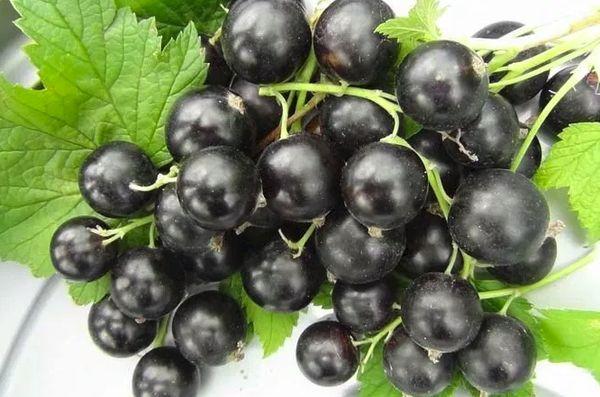
Pros and cons
Many gardeners love this variety for the following advantages:
- high content of vitamins, pectin in berries;
- return of stable high yields;
- frost resistance;
- the presence of beautiful golden flowers that adorn the site;
- maximum safety during transportation;
- withstanding high humidity, sudden temperature changes;
- immunity to anthracnose, kidney mites.
The disadvantage of the variety is its inability to powdery mildew. Currants are a little sour, which is also unacceptable for some summer residents.
Black pearls are a hardened and winter-hardy variety, because the selection was made in the latitudes of Siberia. But already the variety is considered obsolete due to the breeding of newer species. Although gardeners still prefer and love it for its many virtues.
Features of growing varieties
Pearls are an unpretentious variety that inherited the best qualities from their relatives. Although, in order to obtain decent harvests, it is important to adhere to certain rules of agricultural technology:
- Planting of seedlings is carried out mainly in the fall (early October) at t + 10 + 12 degrees, so that they have time to take root in a new place before the onset of cold weather.
- It is important to choose lighted areas for planting, away from drafts.
- Not recommended for planting in the shade.
- Bushes should not shade each other, therefore the optimal distance between them is 2-2.5 m.
- The best soil is light and slightly acidic, equipped with nutrients, and also moist, otherwise the berries will ripen slowly, acidic and small.
Reference! The main points of agricultural technology for this variety are the correct planting and formation of bushes. When planting in the fall, young seedlings begin to grow rapidly and gain strength in the spring, bear fruit in the second year up to 2 kg per bush.
Seat selection
For comfortable and fast development, it is recommended to plant Black Pearls in open sunny areas, protected from the winds. The soil is ideally loose, nutritious, slightly acidic.
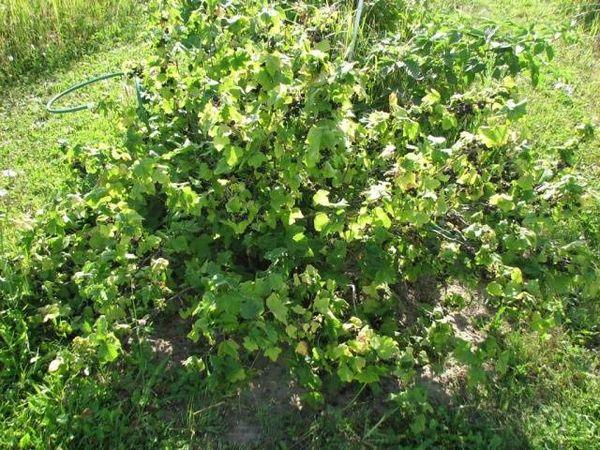
Currants do not tolerate drought, stagnation of water in the soil, tightness and shade. When planting shrubs, it is important to maintain a distance between them of at least 1.5 m.
Landing dates
The plant can be planted throughout the growing season:
- in the fall in early October, so that the currants have time to gain strength, take root before the first frost;
- in the spring until the buds swell.
In the first year, the seedlings do not bear fruit, but only grow and strengthen. It will be possible to try the first berries in the second year with a yield of up to 2 kg from 1 bush.
Advice! If it is supposed to be planted in the spring, then all work should be done in the fall.
Site preparation
The site must be prepared in advance, 1.5-2 months before planting the seedlings:
- weeds are uprooted;
- the earth is dug up, loosened up to increase the air throughput;
- equip with humus, compost;
- apply potash fertilizers, superphosphate if necessary.
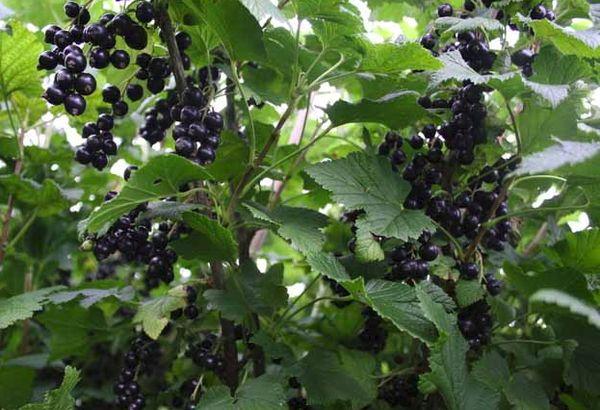
Selection of seedlings
When buying shrubs, it is important to inspect the root system to keep it strong and healthy. Also, 4-5 green buds should depart from the base of the shoots.
Planting instructions
Prepared place in advance:
- free from grass, vegetation;
- dig up the soil up to 1.5 m deep;
- equip with fertilizers, humus (1 bucket), pouring 1m under each bush2 (you can use superphosphate, potash or mineral fertilizer).
Landing steps:
- soak the seedlings in water for 2-3 hours so that the roots absorb the required amount of moisture;
- dip in a clay mash for a few minutes;
- plant the plants in pits so that the root system remains slightly above the ground (4-5 cm);
- position the seedlings at an angle of 45 degrees between the surface of the soil and the trunk;
- spill holes with settled water (up to 2 buckets);
- mulch the tree trunks with peat, compost, sawdust to retain moisture in the soil;
- cut off shoots from the ground by 15 cm, leave 5-6 buds.
Black pearls are a sprawling shrub, so it is important to plant at a distance of 2 m from each other. When planting in autumn, the air temperature should not be below +8 degrees, so that the shrubs have time to take root before winter and easily endure frosts.
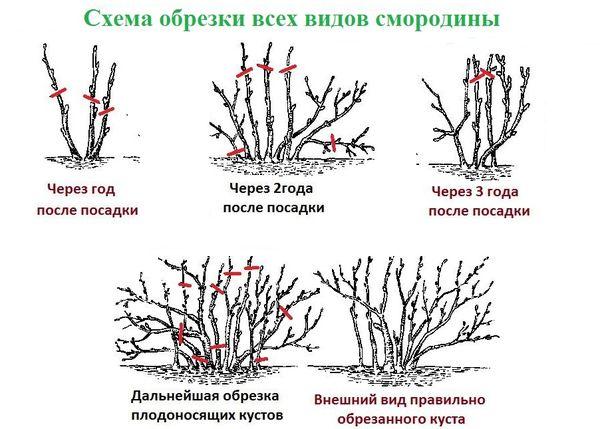
Subtleties of currant care
The main subtleties when leaving for stable yields. Important:
- mowing the grass around the circumference of the bushes as soon as they appear;
- loosen the soil, enrich with oxygen;
- carry out abundant watering of up to 3 liters of water under each root during flowering and fruiting of bushes in order to saturate with a sufficient amount of moisture before wintering;
- apply fertilizers, top dressing in the fall (phosphorus, potassium), in the spring - urea;
- prune periodically: the first pruning - immediately upon planting, leaving 5-6 buds on the shoots;
- remove excess basal, diseased and broken branches, also shoots older than 3 years, leaving only healthy branches of different ages.
Reference! It is not recommended to stuff the soil with humus and fertilizers. If mulch was introduced when planting bushes, then organic matter is no longer required.
Watering rules
The soil should not dry out, therefore it is important to provide the currant bushes with timely watering. Especially during the period of fruiting, ripening and flowering. It is also worth shedding soil under each bush before wintering.
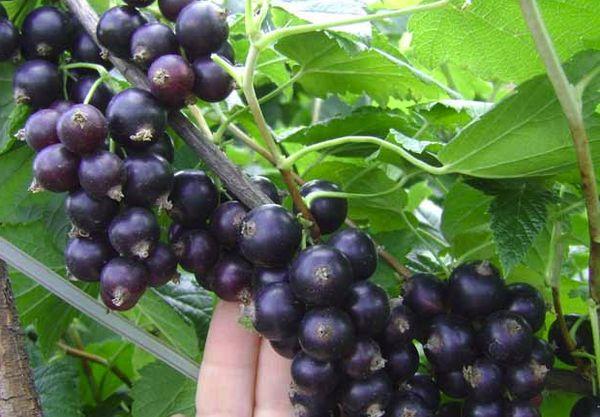
Fertilization
It is worth adding top dressing periodically, using chicken droppings, a weak mullein solution. During the flowering period of seedlings, organic matter can be used.
Bush formation
The formation process is the removal of old unnecessary shoots and branches, the redirection of nutrient components to promising areas. When planting currant seedlings, it is important to cut the shoots, leaving up to 4 buds on each trunk, thus stimulating the development of lateral shoots for 2-3 years.
It is recommended to cut off excess one-year-old shoots at the base of the bush, and so on annually, ending only in the 4th-5th year.
A fruiting bush should have branches of different ages. It is important to remove only diseased, broken and affected shoots. Also cut out young ones that do not give growth.
Wintering
Winter hardiness of the Black Pearl currant is high. The bushes are quite resistant to frost at -35 degrees. However, in the first year of life, it is important to cover young sprouts for wintering to protect them from freezing, filling the bushes with soil by 15 cm.With the first snow, you can compact the ground around the circumference of the bushes and put agrofibre.

Treatment of plants from diseases and pests
The main enemy of currants is powdery mildew, which affects young seedlings until death.
Chemical options for combating the disease:
- Infusion of mullein and water (1: 3). You can use hay dust instead of mullein. Withstand the solution for 3 days, add more water, drain. Spray each bush. Repeat the procedure after 2 weeks and a third time in mid-June.
- Vitriol with the product of treatments before flowering and after harvesting currants.
It happens that, with untimely care, the shrubs are affected by spider mites and sawflies. For treatments, special preparations are applicable ("Dichlorvos", "Fitoverm").
If you provide the currants with timely and proper care, then it is unlikely that pests will settle on strong bushes with good immunity.
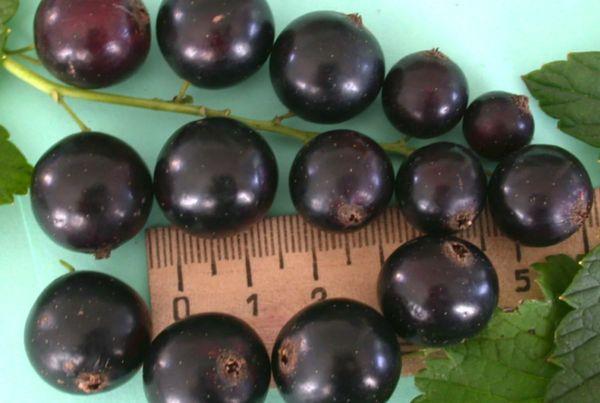
Breeding methods
Black pearl currant propagates in 3 ways: layering, green or lignified cuttings.
Harvesting and storage
The variety is considered mid-season, so the first collection of up to 3.5 kg from 1 bush will be ready by July. The skin of the fruit is dense.They will hang on the bushes until the end of August, neither subside, without losing their taste. The berry is easy to transport. It can be kept in the refrigerator for up to 20 days.
The conclusion based on the description, characteristics of the Black Pearl currant variety is as follows: yield - high, cold resistance - up to 40 degrees. Berries have a sour taste, so it is better to eat them fresh. Due to the high content of pectin from currants, high-quality jelly jam is obtained.
